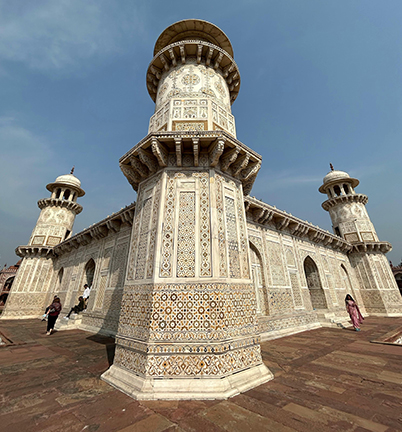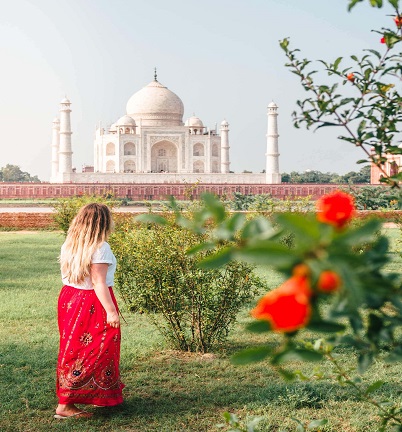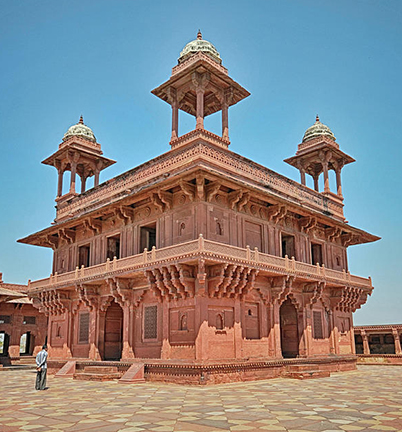Travel
Major Attractions

Taj Mahal
The Taj Mahal in Agra, India, is globally renowned for its exquisite beauty and historical significance. Built by Emperor Shah Jahan in the 17th century as a mausoleum for his beloved wife, Mumtaz Mahal, it symbolizes eternal love.
Distance
- Distance from Our Hotel to Taj South Gate is 1 km.
- Distance from Our Hotel to Taj East Gate is 3 km.
- Distance from Our Hotel to Taj West Gate is 3.5 km.
Key Points
- The Taj Mahal captivates millions with its symmetrical grace.
- Golf cart is only available on Taj East Gate.
- Magnificent white structure gleams in Moonlight.
- Parking is only available at the east and west gates.
- Battery vehicles shuttle from parking to Taj gates.
- The distance from the Taj Mahal parking to its gate is 600 meters.
Highlight
- Taj Mahal Remains closed on friday for maintenance purpose.
- Open from Sun Rise to Sun Set.
- Taj Mahal Full Moon Date : 23-4-2024, 23-05-2024, 22-06-2024, 21-07-2024, 19-08-2024, 18-09-2024, 17-10-2024, 15-11-2024, 15-12-2024, 13-01-2025, 12-02-2025, 13-03-2025.
- Taj fullmoon ticket can be booked from ASI Office before 24 hrs. Soon you can book online.
- ASI Office is only 500 meters from the hotel.
Agra Fort
The Agra Fort, a UNESCO World Heritage Site, is a historic fortress located in Agra, India. Constructed by Emperor Akbar in the 16th century, it served as the primary residence of the Mughal emperors until the capital was shifted to Delhi.The fort showcases a fusion of Islamic, Persian, and Hindu architectural styles.
Distance
- Distance from Our Hotel to Agra Fort is 2.5 km.
Key Points
- Agra Fort formidable historical significance endures.
- Intricate designs and imposing red sandstone walls.
- Overlooks the Yamuna River, enhancing its grandeure walls.

.jpg)
Akbar Tomb
Akbar's Tomb, located in Sikandra near Agra, India, is a grand mausoleum dedicated to Emperor Akbar, the greatest of the Mughal rulers. Built in the late 16th century, the tomb blends Mughal, Persian, and Hindu architectural styles, featuring a majestic gateway, lush gardens, and a massive marble tomb chamber.
Distance
- Distance from Our Hotel to Akbar Tomb is 12-15 km.
Key Points
- Reflects Akbar's religious tolerance and beliefs.
- Impressive structure with intricate carvings.
- Surrounding Charbagh layout enhances its serene ambiance.
Itmad-ud-Daulah Tomb
The Itmad-ud-Daulah Tomb, often referred to as the "Baby Taj," is a magnificent mausoleum located in Agra, India. Constructed in the early 17th century, this exquisite marble tomb is renowned for its intricate inlay work and delicate carvings, foreshadowing the architectural splendor of the Taj Mahal.
Distance
- Distance from Our Hotel to Itmad-ud-Daulah Tomb is 5 km.
Key Points
- Overlooks the Yamuna River, enhancing charm.
- Reflects refined Mughal aesthetics and craftsmanship.
- Tranquil setting amidst lush gardens and water channels.


Mehtab Bagh
Mehtab Bagh, located on the opposite bank of the Yamuna River from the Taj Mahal in Agra, India, is a historic garden complex dating back to the Mughal era. Translating to "Moonlight Garden," Mehtab Bagh offers panoramic views of the Taj Mahal, making it a popular spot for visitors seeking stunning vistas.
Distance
- Distance from Our Hotel to Mehtab Bagh is 5 km.
Key Points
- Ideal for witnessing Taj Mahal's stunning hues.
- Perfect backdrop for capturing Taj's beauty.
- Features diverse flora enhancing its scenic appeal.
Fatehpur Sikri
Fatehpur Sikri, a UNESCO World Heritage Site, is a historical city located near Agra, India. Constructed in the 16th century by Emperor Akbar, it served as the capital of the Mughal Empire for a brief period. The city boasts splendid architectural masterpieces, including the Jama Masjid, Buland Darwaza.
Distance
- Distance from Our Hotel to Fatehpur Sikri is 40 km.
Key Points
- Unique structures like Panch Mahal showcase creativity.
- Exquisite structures adorned with intricate carvings.
- Once served as the Mughal Empire's capital.
- Golf carts are available in Fatehpur Sikri.


The Agra Metro
Note : The metro is available from the Taj East Gate to Mankameshwar Temple and it will be extended up to Sikandara soon.

